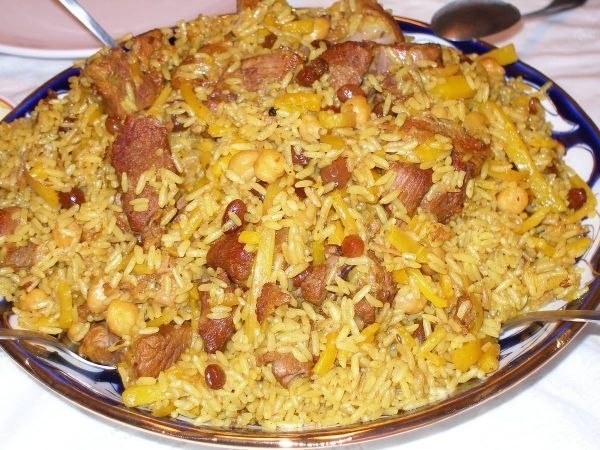The dispute about whether it is necessary to soak the rice intended for pilaf, not make sense, since it depends on the technology of cooking. No wonder the Turkish proverb says "there are so many kinds of pilaf, how many cities in the Muslim world". The main differences lie not only in the combination products siraka - roast in vegetable oil of onions, carrots, meat, fruits, vegetables, spices, but also in the preparation of cereal components. Because the rice sometimes it is connected with servicom in the cooking process, and in some cases extinguished separately. This dish appeared in the middle East with the culture of rice cultivation (II—III century BC), and then was picked up by the inhabitants of Central Asia, and if we take a sample of Central Asian pilaf, the rice is always soaked for him. The only question is, what is the rice to soak and for how long.
As a result of cooking risotto, the rice must be quite crumbly, but not dry, not each variety of rice suitable for this dish. Each plouvara have to adapt to selling in the region of varieties because each of them requires its own approach. For example, the most popular Uzbek rice pilaf is famous virgins-Zira", which is grown in Ferghana, Andijan regions. Some versions of 'dev-cumin" can be found on the territory of Kyrgyzstan, Uzgen. Uzgen rice "Chungara" lighter and starchy, but has excellent water absorption.
If subspecies have differences, they are minor. Grain is elongated, but not thin in circumference, color starchy powder after washing can vary from pink to brick. Even washed until transparent rice, not usually pure white, with some brown or red inclusions. The Russian lady is most often used in pilaf Krasnodar round grade or a long one "Basmati", imported from Pakistan and Afghanistan.
Krasnodar rice is to cook a delicious risotto, only it is somewhat softer Uzbek varieties, and, therefore, steeping should be longer. "Basmati" can also differ in quality depending on the growing area. The content of the starchy substances in it may be almost zero, which does not benefit the taste of the pilaf. The principle of "the whiter and smoother the surface of the grains" is not appropriate for the array of Fig. On the contrary, it should have a roughness to better absorb water, fat, spices.
High coefficient of videogamemaster is the main criterion of rice suitable for risotto. Even after spending several hours in the water, it will not stick to the rice and does not fall apart into small pieces. Before you soak the rice, it should be repeatedly rinsed under running cool water that is called "to clean water". This is done to wash off the excess powdery coating conducive when cooking viscosity. Even if at first glance the figure seems to be completely clean, should be washed 5-6 times prior to stage hours of soaking.
"The virgins-Zira" requires a long soak from one hour to 10, the best is 3-4 hours. In addition, the water should be several inches above the surface of the rice, to prevent him to come into contact with air, which will lead to the excessive softening. Can be filled with water at room temperature or slightly warm with a pinch of salt, but not hot.
If the variety of rice is not on the packaging reliable information and plov is cooked for the first time, it is necessary to observe the grain in the soaking process to determine its readiness. Indicator is a uniform milky-white colour grains. Not to be mistaken in the case of inexperience with time, can be limited to 1.5 - 2 hours. This time range is indicated by most Central Asian recipes for cooking pilaf.
Soaking is necessary to ensure that in the process of cooking the grain reached the condition of almost at the same time. Already put soaked rice into the cauldron and Bay with water (if needed) 1-1. 5 cm above surface of rice, it is important not to simmer on a slow fire and boil for 7-10 minutes at a rapid boil without closing the lid. Only after that fire diminish to a minimum and the pilaf is cooked for 10 more minutes on a slow fire, and then disconnects. Kazan wrapped the top with a towel so as to cover the gap between the cover and utensils. So the rice comes to fitness for another 10-15 minutes. With this technology of cooking, the rice is in a crisp and scented of all the ingredients that are in service.
Whether any rice suitable for risotto
As a result of cooking risotto, the rice must be quite crumbly, but not dry, not each variety of rice suitable for this dish. Each plouvara have to adapt to selling in the region of varieties because each of them requires its own approach. For example, the most popular Uzbek rice pilaf is famous virgins-Zira", which is grown in Ferghana, Andijan regions. Some versions of 'dev-cumin" can be found on the territory of Kyrgyzstan, Uzgen. Uzgen rice "Chungara" lighter and starchy, but has excellent water absorption.
If subspecies have differences, they are minor. Grain is elongated, but not thin in circumference, color starchy powder after washing can vary from pink to brick. Even washed until transparent rice, not usually pure white, with some brown or red inclusions. The Russian lady is most often used in pilaf Krasnodar round grade or a long one "Basmati", imported from Pakistan and Afghanistan.
Krasnodar rice is to cook a delicious risotto, only it is somewhat softer Uzbek varieties, and, therefore, steeping should be longer. "Basmati" can also differ in quality depending on the growing area. The content of the starchy substances in it may be almost zero, which does not benefit the taste of the pilaf. The principle of "the whiter and smoother the surface of the grains" is not appropriate for the array of Fig. On the contrary, it should have a roughness to better absorb water, fat, spices.
Rules for soaking the rice
High coefficient of videogamemaster is the main criterion of rice suitable for risotto. Even after spending several hours in the water, it will not stick to the rice and does not fall apart into small pieces. Before you soak the rice, it should be repeatedly rinsed under running cool water that is called "to clean water". This is done to wash off the excess powdery coating conducive when cooking viscosity. Even if at first glance the figure seems to be completely clean, should be washed 5-6 times prior to stage hours of soaking.
"The virgins-Zira" requires a long soak from one hour to 10, the best is 3-4 hours. In addition, the water should be several inches above the surface of the rice, to prevent him to come into contact with air, which will lead to the excessive softening. Can be filled with water at room temperature or slightly warm with a pinch of salt, but not hot.
If the variety of rice is not on the packaging reliable information and plov is cooked for the first time, it is necessary to observe the grain in the soaking process to determine its readiness. Indicator is a uniform milky-white colour grains. Not to be mistaken in the case of inexperience with time, can be limited to 1.5 - 2 hours. This time range is indicated by most Central Asian recipes for cooking pilaf.
Soaking is necessary to ensure that in the process of cooking the grain reached the condition of almost at the same time. Already put soaked rice into the cauldron and Bay with water (if needed) 1-1. 5 cm above surface of rice, it is important not to simmer on a slow fire and boil for 7-10 minutes at a rapid boil without closing the lid. Only after that fire diminish to a minimum and the pilaf is cooked for 10 more minutes on a slow fire, and then disconnects. Kazan wrapped the top with a towel so as to cover the gap between the cover and utensils. So the rice comes to fitness for another 10-15 minutes. With this technology of cooking, the rice is in a crisp and scented of all the ingredients that are in service.

